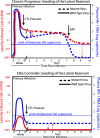The implications of viral reservoirs on the elite control of HIV-1 infection
- PMID: 22864624
- PMCID: PMC11113402
- DOI: 10.1007/s00018-012-1101-7
The implications of viral reservoirs on the elite control of HIV-1 infection
Abstract
The mechanisms by which a small percentage of HIV-1 infected individuals known as elite suppressors or controllers are able to control viral replication are not fully understood. Early cases of viremic control were attributed to infection with defective virus, but subsequent work has demonstrated that infection with a defective virus is not the exclusive cause of control. Replication-competent virus has been isolated from patients who control viral replication, and studies have demonstrated that evolution occurs in plasma virus but not in virus isolates from the latent reservoir. Additionally, transmission pair studies have demonstrated that patients infected with similar viruses can have dramatically different outcomes of infection. An increased understanding of the viral factors associated with control is important to understand the interplay between viral replication and host control, and has implications for the design of an effective therapeutic vaccine that can lead to a functional cure of HIV-1 infection.
Figures



References
-
- Migueles SA, Osborne CM, Royce C, Compton AA, Joshi RP, Weeks KA, Rood JE, Berkley AM, Sacha JB, Cogliano-Shutta NA, Lloyd M, Roby G, Kwan R, McLaughlin M, Stallings S, Rehm C, O’Shea MA, Mican J, Packard BZ, Komoriya A, Palmer S, Wiegand AP, Maldarelli F, Coffin JM, Mellors JW, Hallahan CW, Follman DA, Connors M. Lytic granule loading of CD8+ T cells is required for HIV-infected cell elimination associated with immune control. Immunity. 2008;29:1009–1021. doi: 10.1016/j.immuni.2008.10.010. - DOI - PMC - PubMed
-
- Migueles SA, Sabbaghian MS, Shupert WL, Bettinotti MP, Marincola FM, Martino L, Hallahan CW, Selig SM, Schwartz D, Sullivan J, Connors M. HLA B*5701 is highly associated with restriction of virus replication in a subgroup of HIV-infected long term nonprogressors. Proc Natl Acad Sci USA. 2000;97:2709–2714. doi: 10.1073/pnas.050567397. - DOI - PMC - PubMed
-
- Lambotte O, Boufassa F, Madec Y, Nguyen A, Goujard C, Meyer L, Rouzioux C, Venet A, Delfraissy JF, SEROCO-HEMOCO Study Group HIV controllers: a homogeneous group of HIV-1-infected patients with spontaneous control of viral replication. Clin Infect Dis. 2005;41:1053–1056. doi: 10.1086/433188. - DOI - PubMed
-
- Emu B, Sinclair E, Hatano H, Ferre A, Shacklett B, Martin JN, McCune JM, Deeks SG. HLA class I-restricted T-cell responses may contribute to the control of human immunodeficiency virus infection, but such responses are not always necessary for long-term virus control. J Virol. 2008;82:5398–5407. doi: 10.1128/JVI.02176-07. - DOI - PMC - PubMed
Publication types
MeSH terms
LinkOut - more resources
Full Text Sources
Medical

